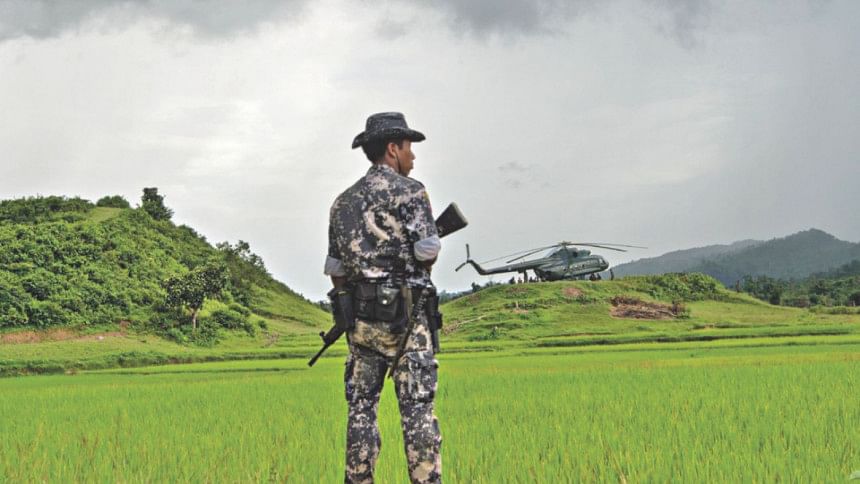Rakhine: Where China meets India

China and India's steady economic growth after centuries of stagnation is changing the economic landscape of Asia—lifting millions out of poverty. As economic interdependence between the two nations increases, their geo-political rivalry is also on the rise. Beijing and New Delhi have competing visions to expand their geo-economic interests and, perhaps, supremacy in the region and beyond.
China has launched its grand vision under the aegis of Belt and Road Initiative (BRI) in 2013. The ocean-based 21st Century Maritime Silk Road and the overland Silk Road Economic Belt to increase trade and connectivity are backed by Beijing's deep pockets.
India's vision is to expand its economic and strategic interests in its immediate neighbourhood and forge comprehensive ties with ASEAN. New Delhi intends to access overland routes to Europe and Central Asia bypassing Pakistan, reflected in its port development in Chabahar, Iran.
China is well ahead of India at this stage expanding its strategic vision with an expectation that all roads will lead to Beijing. New Delhi is opposing China's BRI—leading to geo-political rivalry in Asia. There are heightened tensions between China and India on the former's development of multibillion dollar China-Pakistan Economic Corridor.
The recent standoff between the two giants at the high altitudes of the Himalayas is yet another example of New Delhi's policy to arrest Beijing's strategic interests in South Asia. It is China's port and other strategic infrastructure buildup in Sri Lanka that has triggered alarm bells.
Nevertheless, Myanmar is the place where both China and India's presence is visible more than anywhere else. To be more precise, it is the troubled Rakhine State of Myanmar, bordered by Chittagong to the northwest and the Bay of Bengal to the west, that sees a greater presence of both China and India with their investment and influence. Myanmar, which has been highly dependent on China for political and economic backing in the past, is now diversifying its portfolio partnering with India and other countries including Japan and Singapore.
China's interest is nevertheless not limited to the shores of Rakhine. It has been eyeing the development of similar maritime and other infrastructure in Chittagong, barely 150km from Rakhine, further expanding its interests in the world's largest bay. New Delhi is visibly nervous as Chinese presence in Bangladesh rises. It has been successful in thwarting Beijing's multibillion dollar plan to develop a deep sea port in Chittagong.
Bangladesh's failure to utilise its favourable geography for economic benefits has given a huge advantage to Myanmar. Both China and India's importance to Rakhine State has increased many folds. It is hardly surprising that Naypyidaw has bagged the support of both Beijing and New Delhi, and even Tokyo, on the Rohingya refugee crisis.
Moreover, given the importance of Rakhine and Chittagong in the Bay of Bengal region it is also imperative to explore if the ongoing Rohingya refugee crisis has any link to the strategic rivalry of regional powers. A lingering refugee crisis means there is little hope that Chittagong will have direct links with China and ASEAN through Myanmar. Moreover, Beijing's plan to reduce its dependence on the Straits of Malacca by securing an alternative energy and trade route through Myanmar might have cost strategic interests of some big powers who may have something to gain from the region being volatile.
Against this backdrop, the geo-economic and strategic equations involving China, India, Myanmar and Bangladesh need to be explored. Earlier, these four nations agreed to work jointly forming a sub-regional cooperation under the aegis of BCIM Economic Corridor but its future seems uncertain given New Delhi and Beijing's growing rivalry. It is also important to understand Myanmar's internal developments, both in terms of politics and economics.
Myanmar: An anthropologist's paradise and a statesman's nightmare
Myanmar is a highly complex society given the presence of a large number of ethnic groups and the country's linguistic and cultural diversity. There are 11 major ethnic groups. The country has seven Bamar regions and seven ethnic states, and six self-administration areas. There are 110 armed organisations of different sizes, most of them ethnic-based.
Civil war and ethnic conflicts have been a constant feature of Myanmar's socio-political landscape since the country attained independence from the British in 1948. In fact, ever since the British landed in Burma in 1886 it adopted the infamous "divide and rule" policy empowering the ethnic minorities instead of the Bamar, who constitute majority of the population, sowing the seeds of centuries-long ethnic conflicts.
After independence, the military controlled the country, fighting communists and various ethnic groups. They include, among others, the Kachin Independence Army, Rohingya Muslims, Shan, Lahu, and Karen minority groups. It is not only the Rohingya who have been forced to leave Myanmar; over the past two decades, about 100,000 Karen refugees have taken shelter along the Thailand-Myanmar border. There have been frequent armed conflicts between ethnic Chinese rebels and the military.
Having failed to crush the ethnic armed groups, the military adopted a reconciliatory approach in the 1990s, assimilating all ethnic minorities and faiths save the Rohingya Muslims into the Buddhist-majority Bamar community. During 2011–16, a national ceasefire agreement was reached involving armed ethnic groups, although half of them did not sign it. In addition, the military government initiated democratic reforms in mid-2000s. In this pursuit, a new constitution was adopted in 2008 and a national election was held in 2010 resulting in a quasi-democratic government dominated by the military.
However, in a free and fair election in 2015 the National League for Democracy (NLD) led by Aung San Suu Kyi won a landslide victory. The NLD leader was given the position of state counsellor but analysts believe it's the military that pull the strings behind the scenes. In the current format of governance, the military holds three key ministries, a quarter of seats in parliament, and control over the army and police—leaving a big question mark on Myanmar's "democratic transition".
Economic transition of Myanmar
Since its transition to democracy, the Myanmar economy witnessed steady GDP growth. It is fast becoming a transportation hub of Southeast Asia. The country has been upgrading 36 north-south roads and 45 east-west roads to union highways forming a national network of highways. There are at least three cross-border transport corridors being developed in the country linking Thailand, China, Cambodia, Vietnam and northeast India. There's a lot of interest among Asian and other countries to invest in the country. The government has also been developing three special economic zones along with three river and deep ports, namely, Thilawa (south of Yangon), Dawei (southeastern Myanmar) and Kyaukphyu (Rakhine).
Amidst this political and economic transition one sees greater interests of both China and India in Myanmar. The country will remain vital for regional powers irrespective of regime type. Bangladesh also needs prudent strategies to deal with the country, given the rapid changes in Rakhine and Bay of Bengal.
M Shahidul Islam is an economist. Email: [email protected]





Comments